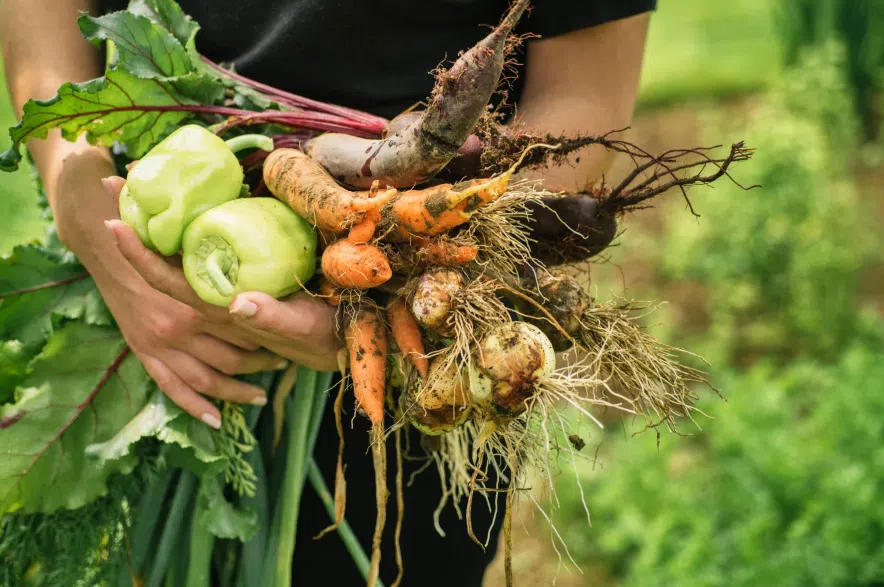Jill and Rick Van Duyvendyk answer all your gardening questions in Garden Talk on 650 CKOM and 980 CJME every Sunday morning at 9 a.m. Here are some questions and answers from the July 20 show:
Read more:
- Garden Talk: How can I prevent maggots in my cherries?
- Garden Talk: Give your summer lawn some love
- Garden Talk: Save money by being water wise in your yard this summer
- Garden Talk: Xeriscaping a water-conscious alternative to having a lawn
These questions and answers have been edited and condensed for clarity.
Q: Is it OK to trim Saskatoon berries now that are too tall to reach?
A: The best time to cut them down is in late in the fall after the leaves start turning colour or fall off. Don’t go any shorter than four feet, that gives you a lot of branches at the bottom to recreate your plant.
You can cut them down to the ground, but it takes so long for them to come back. Most are going to grow to 12 feet tall, except for the Smoky variety which are a little bit shorter.
Saskatoon berry farmers keep them to a height where they can pick them or use a mechanical harvester.
Q: My carrots are getting really tall, should I cut the tops off?
A: You can cut a little bit off the tops, but don’t cut them all the way down — only about a third.
Make sure you’re not over fertilizing them. Often you can get a lot of tops because there’s too many nutrients making all that green and then they don’t actually need a lot of nutrients to create the bottoms.
Also make sure that they’re thinned out so you don’t have a lot of them tight
together. There can be alot of greenery sometimes if they are planted in a shady location as well, because then the heat’s not going down into the ground.
Q: When is the best time to thin carrots?
A: Thin them as early as possible. Carrots don’t like their root system disturbed too much. Give them a pinky width between each stem coming out of the ground.
Q: Is removing potato flowers from the plants beneficial to promote potato growth?
A: You need some flowers to produce potatoes. Later in the season if you think you have enough potatoes growing you can remove the flowers, but you need the flowers at the beginning.
Q: My tomato plants don’t have much fruit. Why aren’t there more?
A: It’s been a late season for tomatoes. The start of the season was really slow, and they need some heat now in many parts of the province.
When it’s when it’s getting hot and then it’s cold and it’s hot and it’s cold, you want to make sure to check your soil and make sure that you’re keeping it evenly moist.
Don’t water the same way all the time with fluctuations in temperatures, stick your finger into the soil seeing whether it needs water or not.
Because it’s a later season is make sure you pollinate. Take a Q-tip and ruffle the blossoms a little bit.
Use a tomato fertilizer, like an organic one with lots of calcium to help them catch up because we’ve still got lots of time yet between now and when you’re going to be harvesting.
They like calcium nitrate, boron, and magnesium. Don’t put a ton of nitrogen on, but you need a little bit of nitrogen, a little bit of phosphorus, and then some potassium and all the other micronutrients.
Q: I watered my plants with too much Miracle Grow and the leaves are falling off. What can I do to correct my mistake?
A: If you’ve applied too much Miracle Grow, the first thing you’re going to see is burning in the leaves, they may turn a purple colour or even black and then get crispy. You will see it on the tips and in between the veins.
If you’ve over fertilized a plant the best thing to do is leach that fertilizer out of the soil by giving it a good amount of water and aerate the soil, because a lot of extra water is also going to cause where your plants can become saturated and can’t soak up any nutrients.
Prune off any of the leaves that are crispy to prompt some new growth, too. It also depends on the type: If it’s an annual, pinching and pruning makes the plant bushier. It’s a vegetative plant it’s quite difficult to over-fertilize unless you’ve poured it straight on the leaves, which will cause burning.
Q: What causes the fruit on pear trees to go from very hard to rotten?
A: It depends on the variety and the season. If it’s an old variety they’re often very hard, but some of the new varieties like Prairie Welcome, Golden Spice or Early Gold, tend to ripen better.
Keep your plant healthy using a fruit and berry fertilizer, not a high nitrogen fertilizer but one that has micronutrients like boron, zinc, and magnesium will help the fruit ripen quicker.
If the tree is shaded by another tree, prune or thin that tree so that the sun comes through and hits the fruit tree.
Pears will ripen off the tree — they’ll actually ripen once they hit the ground or they’ve been picked, so make sure that you don’t leave them on the tree too long because they’ll just rot on the tree. You have to pick them at the right time and then store them in a dry, cool spot.
If there is a lot of fruit then thin them to make all the energy go to the remaining fruit. Picking normally begins in September. All the pears that grow in Saskatchewan are quite a hard pair to begin with, they aren’t like the lush, big pears you find in the grocery store. They’re smaller pair and they are quite a bit firmer.
Q: Should you cut raspberries down every few years?
A: The only one to cut down even every year are varieties like Red River that produce fruit in the fall. With varieties like Red Mammoth, Red Bounty and the gold ones like Honey Queen take the third-year canes out every year — cut out the canes that produce this fall. The second-year canes that didn’t have fruit on them are going to produce next year.
When you cut down the canes, especially the older ones, cut them into pieces six to 12 inches long and tie them up in a bundle then stack them up in different places in your yard because those are great places for, for, for things bees and ladybugs and all those kind of things to use as a home. Then you will have pollinators for next year, too.
Q: Can I spray spider mites webs with a sulphur spray now or should I wait?
A: As soon as you notice any spider mites attack right away, even just blasting cold water at them. Sulphur helps, they don’t like it and it mainly makes them to want to go away.
It works well but not 100 per cent, because you’re never gonna get rid of all of them. You want to control the numbers.
Q: Is there anything new for the control of birch leaf miner?
A: No. The problem is that once they get inside the leaf, they’re protected. You
can’t spray them because they’re eating the chloroform in between the layers of the leaf and leaving the skin on the outside which means sprays don’t penetrate to get them.
Birch leaf miner is a fly that comes out of the ground and lays eggs on leaves. When the egg hatches it burrows into the leaf and then mines the green part inside the leaf.
If there’s only a few leaf miners not affecting every single leaf then it’s not
going to really harm and you don’t need to worry.
The best thing to do is keep the tree healthy because insects don’t go after healthy trees as much. Keep it well watered to produce new growth and if you’re doing any pruning, make sure you dispose of the leaves. Don’t let them fall to the ground because then you’re going to continue that cycle.
Q: What can I spray on my cedar shake roof to kill moss that won’t kill my grass after it rains?
A: There’s a product called MossOut that you can spray that’s OK for the lawn as well.
Read more:
- Garden Talk: How can I prevent maggots in my cherries?
- Garden Talk: Give your summer lawn some love
- Garden Talk: Save money by being water wise in your yard this summer
- Garden Talk: Xeriscaping a water-conscious alternative to having a lawn











